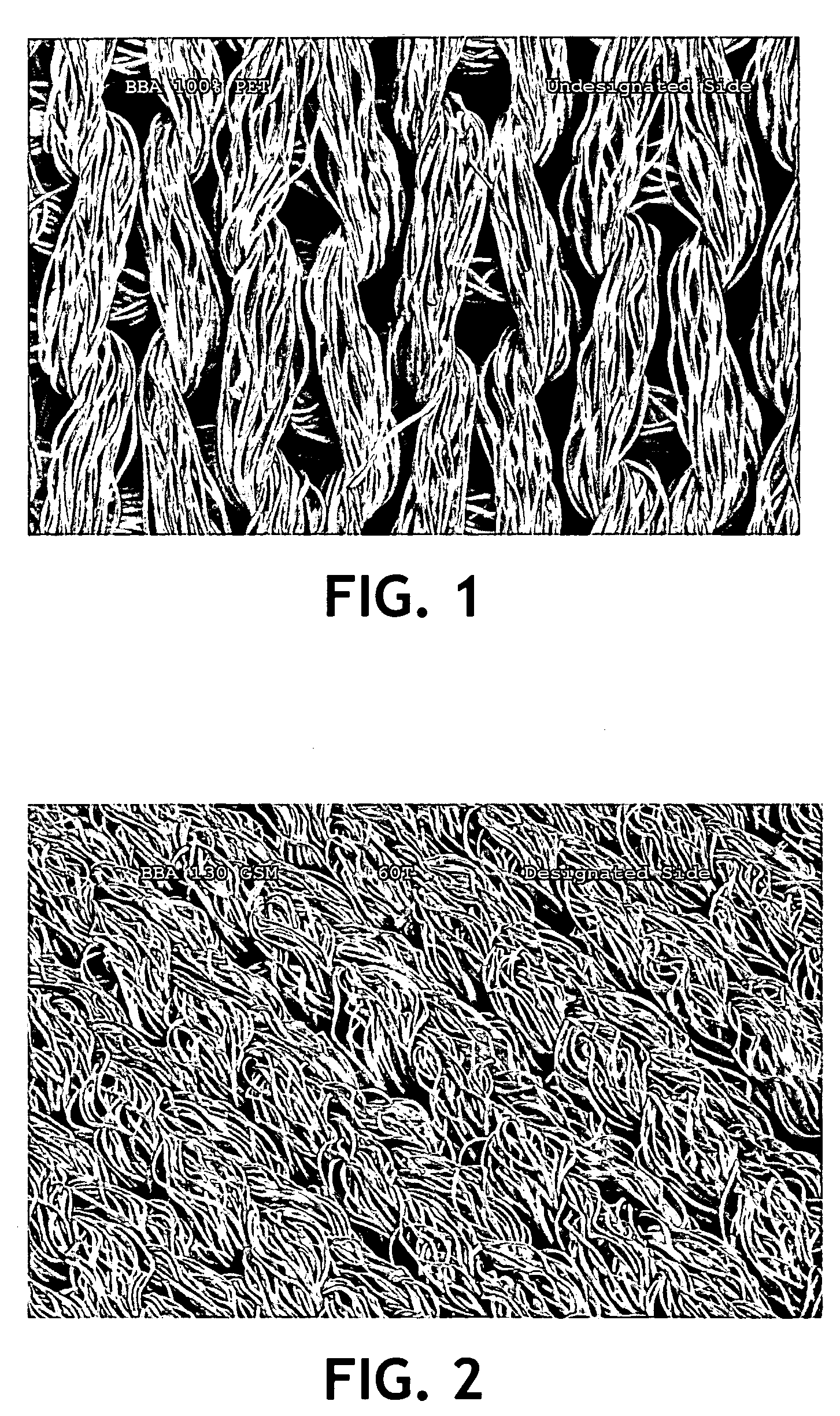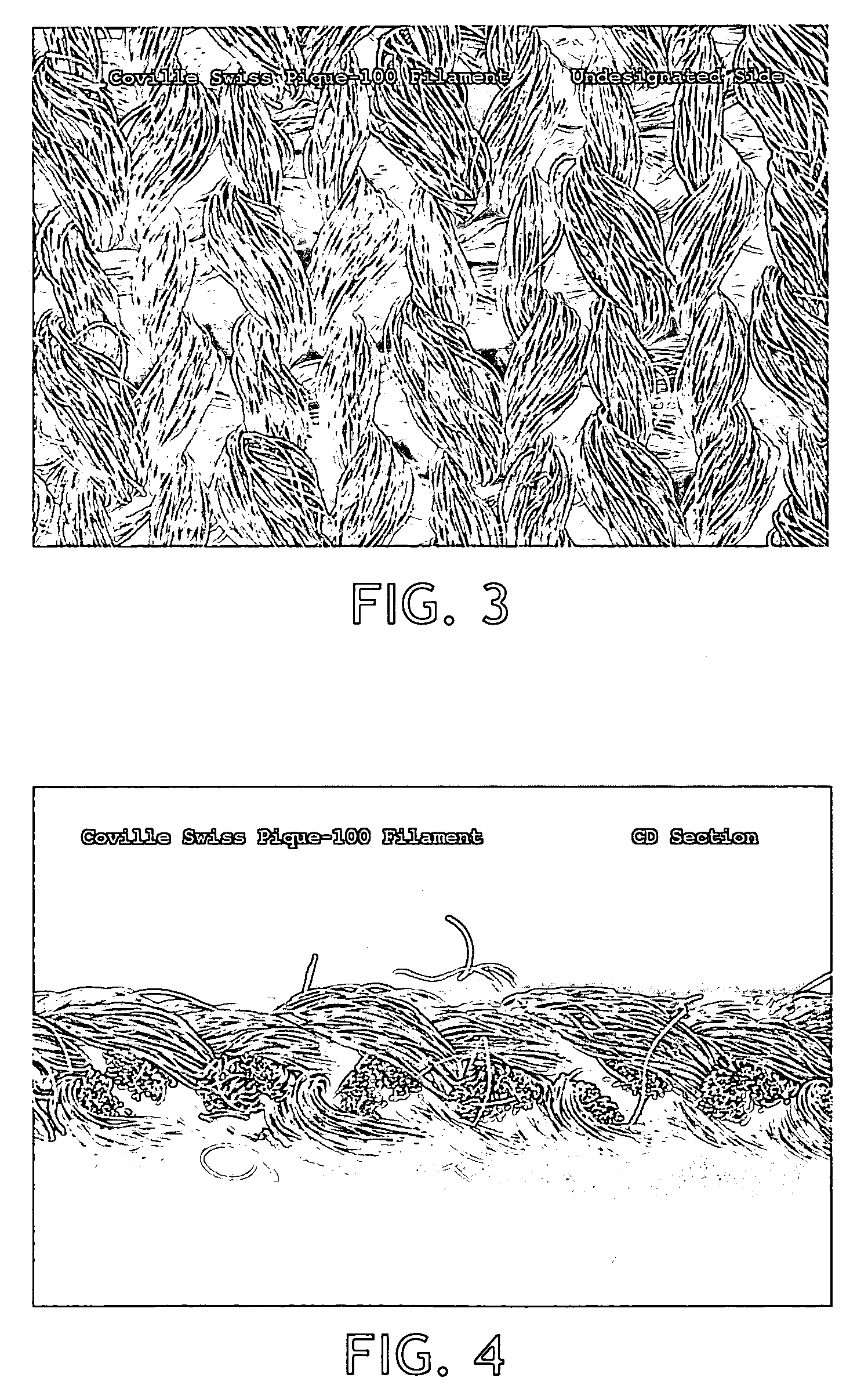Cleanroom wiper
a technology for cleaning rooms and wipers, applied in carpet cleaners, knitting, weaving, etc., can solve the problems of introducing potentially damaging particles into the cleanroom, micro-particles can destroy the circuitry of wafers, and the potential of such contaminants in the room, so as to achieve the effect of greater ability to wipe a surface dry
- Summary
- Abstract
- Description
- Claims
- Application Information
AI Technical Summary
Benefits of technology
Problems solved by technology
Method used
Image
Examples
examples 1-4
[0120] Knitted polyester wipers were used as the base material for Examples 1 through 4. The wipers were 100 percent continuous filament double-knit polyester provided by Quality Textile Company, Mill Spring, N.C. (“QTC”). The fabric was a 135 gsm interlock stitch of 70 denier / 34 filament yarn and having 36 courses and 36 wales. (This material was used throughout sample testing and is referred to herein as the “QTC Control wiper.”)
[0121] The QTC Control wipers were saturated in various baths containing various wetting agents as detailed in Table 2. The Surfynol 440, Surfynol 485, and Dynol 604 were obtained from Air Products Polymers LP, Dalton, Ga. The Unithox 490 was obtained from Baker Petrolite, Sugar Land, Tex.
[0122] After being saturated, the wipers were nipped between two rubber rollers, 1.5 inch (38 mm) in diameter with a 1 / 16 inch (1.6 mm) gap between rollers of an Atlas Laboratory Wringer type LW-1, made by Atlas Electric Devices Co. (Chicago, Ill.). The nipping pressure...
examples 5-7
[0129] In the same manner as outlined above for Examples 1-4, QTC Control wipers were treated with Repel-o-tex (Example 5), Hydropol (Example 6), and Hydrosystem (Example 7), all obtained from Rhodia, Inc., Cranbury, N.J. The wipers were saturated in various baths in the same manner as in Examples 1-4. All of the wipers of Examples 5-7 were saturated to a 0.5% add-on level. Absorbent capacity (water), vertical wicking and wipe dry results for these hand treated samples are shown in Table 4. Data for Comparative Example 2 (i.e., Texwipe Vectra Alpha 10) is included for comparison.
TABLE 4Test Results for Examples 5-7ComparativeExample 5Example 6Example 7Example 2AbsorbentAbsolute3.3303.2902.8502.669Capcity (water)capacity (g)Specific cap.2.8202.7502.5002.056(g / g)Vertical Wicking - CD15 seconds3.2003.1002.9670.200(cm)30 seconds4.3334.2673.9670.20045 seconds5.1335.0334.5670.20060 seconds5.7005.5675.1000.200Vertical Wicking -15 seconds2.8003.6002.5000.100MD (cm)30 seconds4.0004.6003.46...
examples 8-11
[0131] Examples 8-11 were all made using the same QTC Control fabric as used in Examples 1-7. The wipers were chemically treated, as detailed in Table 5, in the rinse cycle of the laundering process during the production of the wipers. The chemical surfactants were manually added during the rinse cycle through the same port used for adding detergent during the wash cycle. Chemical add-on was calculated by weight of the wipers. For example, for a 100 lb. load (45.4 kg) of wipers, 8 ounces (227 g) of surfactant would be added to achieve a 0.5% add-on by weight.
[0132] The wipers were washed by three rinse cycles, each 40 minutes in duration, with a water temperature of about 130 to 160 degrees F. (54-71 degrees C.). The wipers were then dried in a cleanroom dryer for 20 to 30 minutes at a temperature of about 150 degrees F. (66 degrees C.).
TABLE 5Summary of Examples 8-11ExampleChemicalAdd-on (% by weight)8Surfynol 4400.069Repel-o-tex0.0610Surfynol 4850.0611Dynol 6040.06
[0133] Absorb...
PUM
| Property | Measurement | Unit |
|---|---|---|
| Length | aaaaa | aaaaa |
| Fraction | aaaaa | aaaaa |
| Fraction | aaaaa | aaaaa |
Abstract
Description
Claims
Application Information
 Login to View More
Login to View More - R&D
- Intellectual Property
- Life Sciences
- Materials
- Tech Scout
- Unparalleled Data Quality
- Higher Quality Content
- 60% Fewer Hallucinations
Browse by: Latest US Patents, China's latest patents, Technical Efficacy Thesaurus, Application Domain, Technology Topic, Popular Technical Reports.
© 2025 PatSnap. All rights reserved.Legal|Privacy policy|Modern Slavery Act Transparency Statement|Sitemap|About US| Contact US: help@patsnap.com



